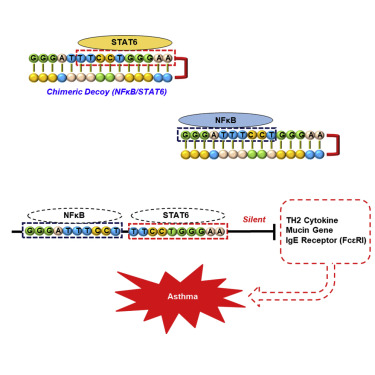Molecular Therapy - Nucleic Acids ( IF 6.5 ) Pub Date : 2017-12-14 , DOI: 10.1016/j.omtn.2017.12.005 Tetsuo Miyake 1 , Takashi Miyake 1 , Makoto Sakaguchi 2 , Hirokazu Nankai 3 , Takahiro Nakazawa 2 , Ryuichi Morishita 1

|
Transactivation of inflammatory and immune mediators in asthma is tightly regulated by nuclear factor κB (NF-κB) and signal transducer and activator of transcription 6 (STAT6). Therefore, we investigated the efficacy of simultaneous inhibition of NF-κB and STAT6 using a chimeric decoy strategy to prevent asthma exacerbation. The effects of decoy oligodeoxynucleotides were evaluated using an ovalbumin-induced mouse asthma model. Ovalbumin-sensitized mice received intratracheal administration of decoy oligodeoxynucleotides 3 days before ovalbumin challenge. Fluorescent-dye-labeled decoy oligodeoxynucleotides could be detected in lymphocytes and macrophages in the lung, and activation of NF-κB and STAT6 was inhibited by chimeric decoy oligodeoxynucleotide transfer. Consequently, treatment with chimeric or NF-κB decoy oligodeoxynucleotides protected against methacholine-induced airway hyperresponsiveness, whereas the effect of chimeric decoy oligodeoxynucleotides was significantly greater than that of NF-κB decoy oligodeoxynucleotides. Treatment with chimeric decoy oligodeoxynucleotides suppressed airway inflammation through inhibition of overexpression of interleukin-4 (IL-4), IL-5, and IL-13 and inflammatory infiltrates. Histamine levels in the lung were reduced via suppression of mast cell accumulation. A significant reduction in mucin secretion was observed due to suppression of MUC5AC gene expression. Interestingly, the inhibitory effects on IL-5, IL-13, and histamine secretion were achieved by transfer of chimeric decoy oligodeoxynucleotides only. This novel therapeutic approach could be useful to treat patients with various types of asthma.
中文翻译:

通过使用嵌合诱饵策略同时抑制NF-κB和STAT6激活来预防小鼠模型中的哮喘恶化。
哮喘中炎症和免疫介质的反式激活受核因子κB(NF-κB)和信号转导子及转录激活子6(STAT6)的严格调控。因此,我们研究了使用嵌合诱饵策略预防哮喘加重的同时抑制NF-κB和STAT6的功效。使用卵清蛋白诱导的小鼠哮喘模型评估诱饵寡聚脱氧核苷酸的作用。卵清蛋白致敏的小鼠在卵清蛋白攻击前3天接受气管内诱饵寡聚脱氧核苷酸的给药。荧光染色标记的诱饵寡聚脱氧核苷酸可以在肺中的淋巴细胞和巨噬细胞中检测到,并且NF-κB和STAT6的激活被嵌合诱饵诱骗寡聚脱氧核苷酸的转移所抑制。所以,用嵌合或NF-κB诱饵寡脱氧核苷酸治疗可防止乙酰甲胆碱诱导的气道高反应性,而嵌合诱饵的寡聚脱氧核苷酸的作用明显大于NF-κB诱饵的寡脱氧核苷酸。嵌合诱饵寡聚脱氧核苷酸的治疗通过抑制白介素4(IL-4),IL-5和IL-13的过表达以及炎性浸润来抑制气道炎症。通过抑制肥大细胞的积累,降低了肺中的组胺水平。由于抑制了MUC5AC基因表达,观察到粘蛋白分泌的显着减少。有趣的是,对IL-5,IL-13和组胺分泌的抑制作用仅通过嵌合诱饵诱饵寡脱氧核苷酸的转移来实现。











































 京公网安备 11010802027423号
京公网安备 11010802027423号